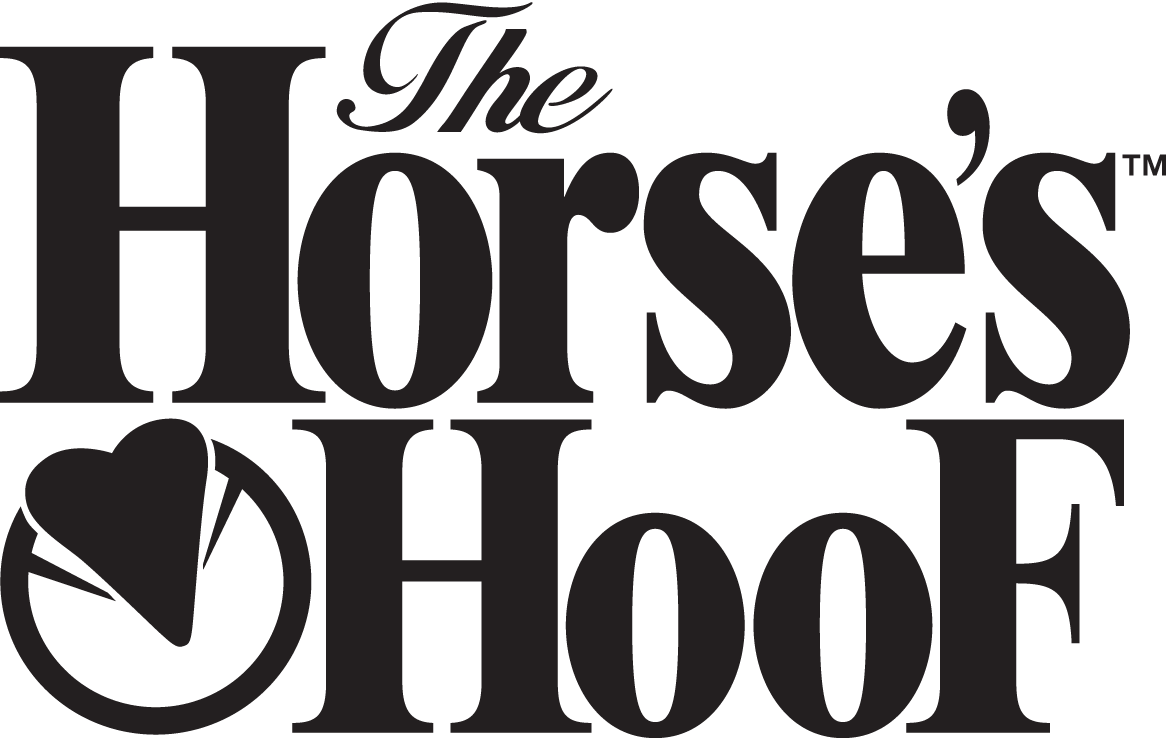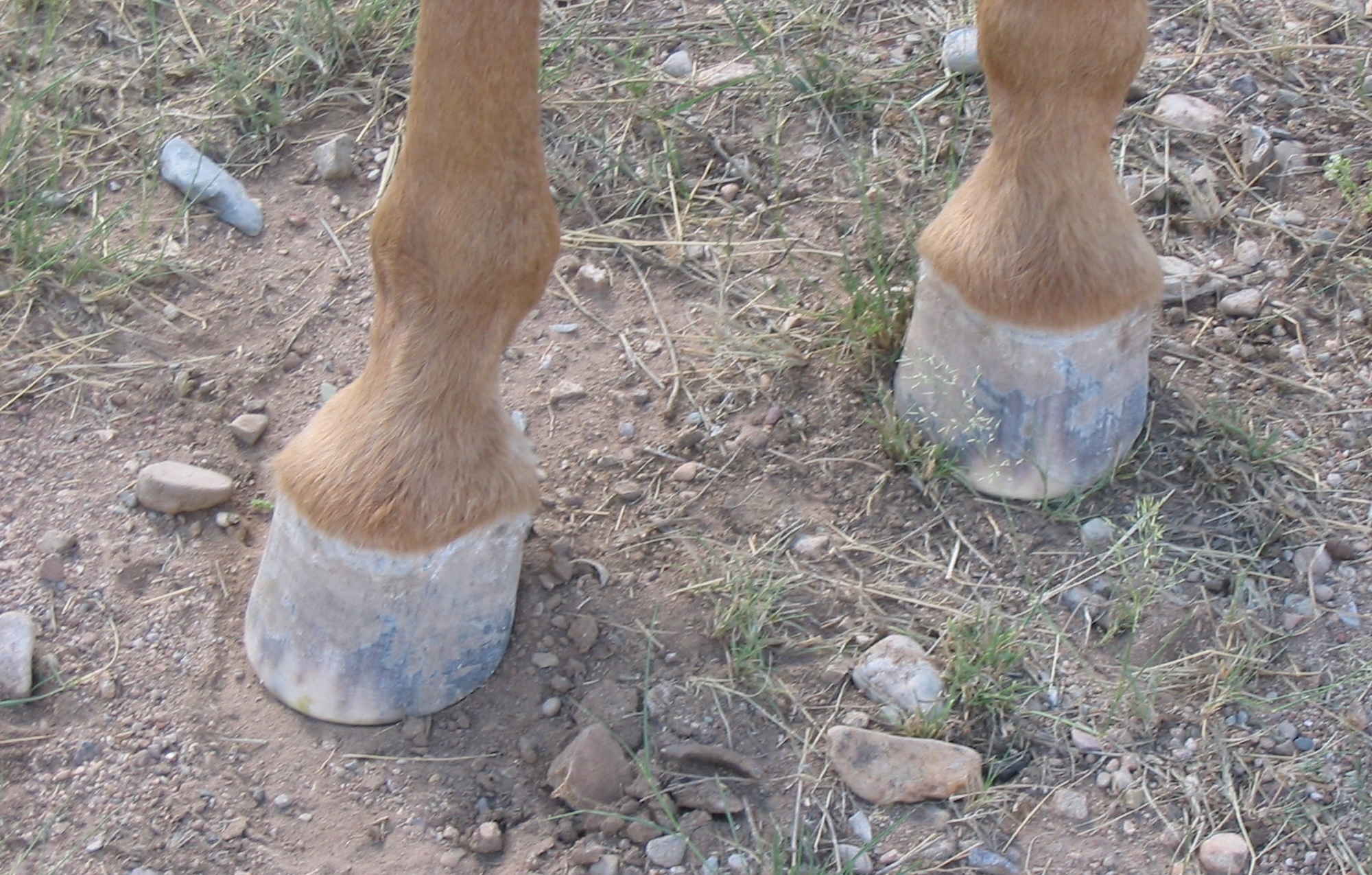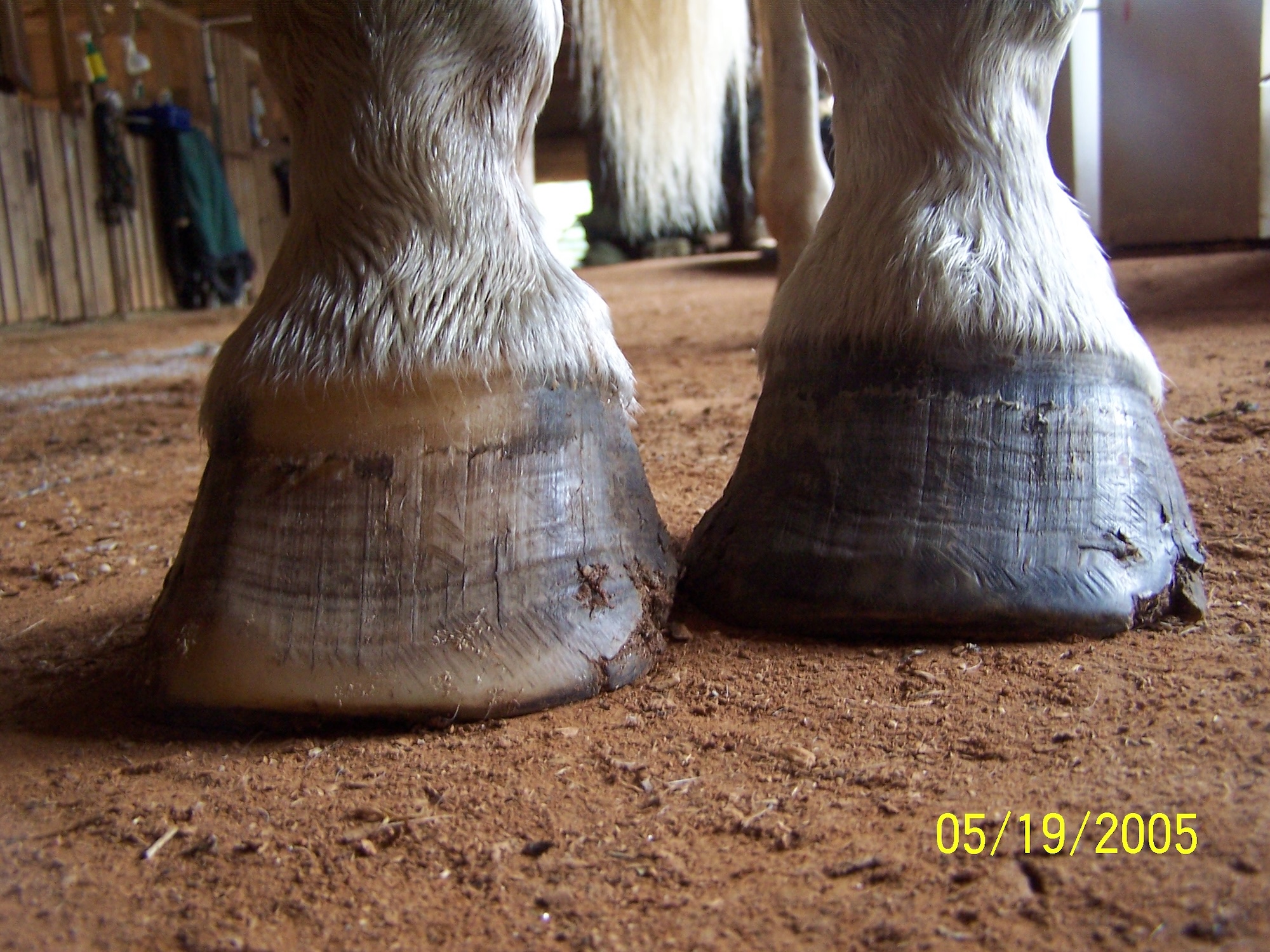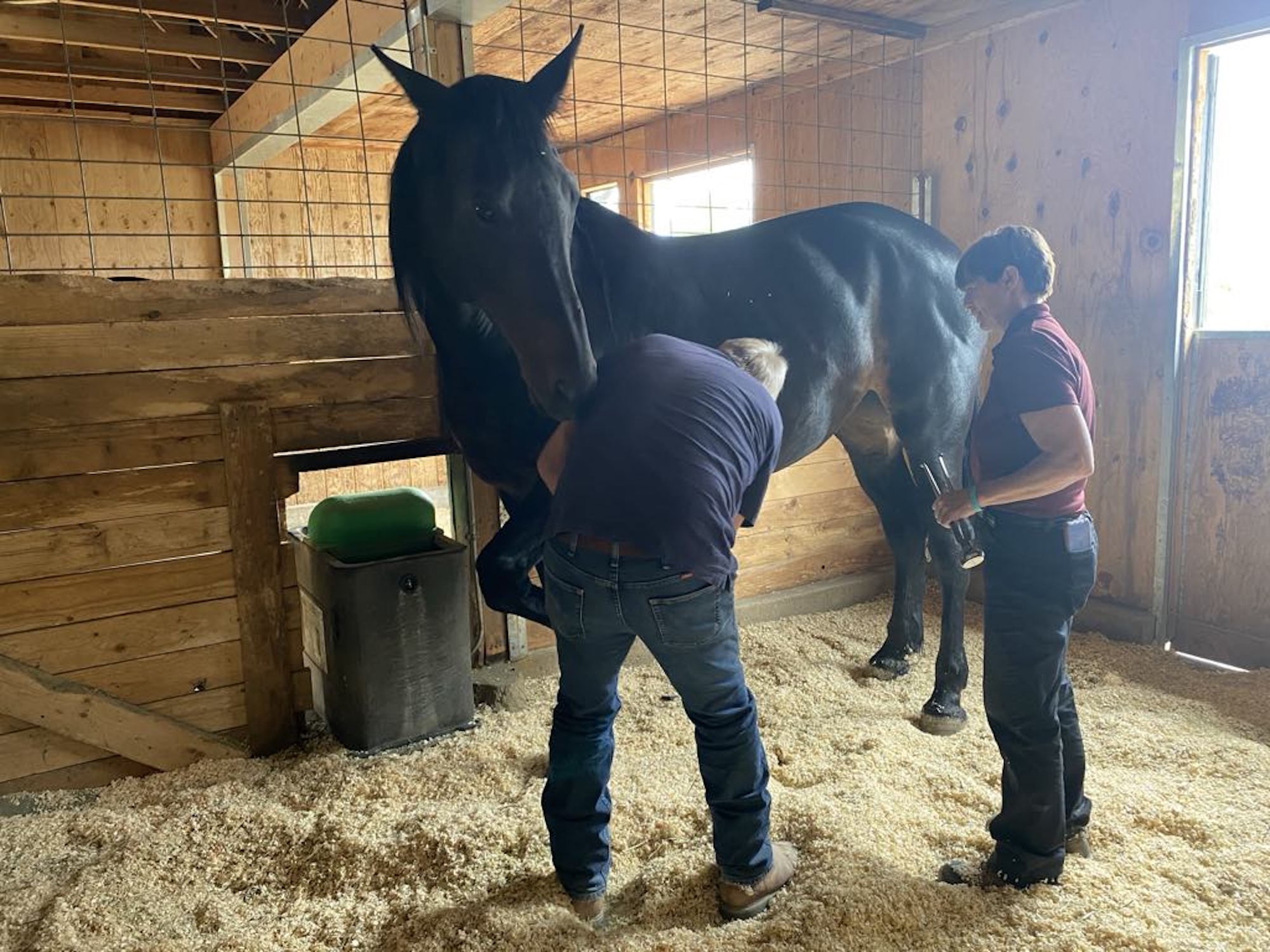A gold standard for hoof care providers worldwide.
We often look to the wild or feral horses of the world for insight in trimming and maintaining our own horses—using them as a model for ideal health and performance. Watching these horses dance across the varied terrains on which they thrive, it is difficult to find fault with their lively and animated movement.
I have the luxury of access to a few thousand acres of rough terrain in central Arizona, and a few dozen horses to watch, as they perform their daily tasks of hunting down their favorite groceries and a cool drink of water in the heat of the day. I have taken a notion to compare the characteristics of their hooves and bodies to those of truly wild or feral horses found elsewhere in the Western USA. My horses also work regularly under tack and rider, and are among the soundest horses I have ever had the pleasure of knowing.
I began to appreciate the overall LACK of differences in my horses versus the feral horses of Utah, Nevada, California and other Western states. The similarities in measurements, angles, frog position and sole depth were easy to recognize. Thus, I began to refer to my model for health and performance as the “self-trimming” hoof rather than the “wild” or “feral” hoof. This simple change in terminology is a more accurate and meaningful way of thinking about and learning from the horses, and lends more credibility to our argument that naturally shaped hooves and bodies are not only healthier, but can outperform more “conventionally managed” horses. What surprises many students of the horse and the hoof, however, are that these self-trimming, working horses can outperform the wild horses as well. Let’s take a look at a few key points behind the power of thinking about the “self-trimming hoof” as the gold-standard for the most serious and successful of hoof care providers.
All photos courtesy Tomas Teskey, DVM
Horse JB, before trimming, Sept. 1, 2004. Overgrown, neglected hooves contracted from years of shoeing:

JB, after initial set-up trim on Sept. 1, 2004. Note layer of “dead” hoof material left intact to exfoliate on its own:

JB self-trimming, April 2005. This photo was taken eight months after JB “went to work” (she had not been trimmed in the slightest since the initial set-up trim pictured above):

One of the well-known functions of the hoof is “excretion of waste,” or, as I like to refer to it, exfoliation. This is the simple, yet powerful, way in which skin structures lose sheets of epidermis, due to pressure. That’s a technical way of saying that skin ends up looking a certain way, depending on work. Its role in shaping the self-trimming hoof is more important to me than its function of waste elimination. Exfoliation is the one function of the hoof that I use to help others understand why trimming can be thought of as “mimicking mileage,” and why it can help immensely in understanding how to help sick hooves become better, and make ordinary horses great performers.
Successful trimmers have a good sense of what exfoliating hoof material looks like, and already use it as their guide—the crumbly, chalky-looking material that easily comes off the sole with a hoof pick or dull hoof knife, and the flared wall that breaks off on hard ground. Using such characteristics as a guide, we can be quite safe in sculpting each hoof on each horse to complement their structure and respect their current situation of environment and lifestyle. Others have written about respecting the “live sole plane,” so this is not a new idea for most trimmers. All self-trimming hooves have a layer of epidermis that is “ready to exfoliate” at all times from ALL surfaces of the hoof…to be without this layer would literally bring an early demise for a wild or feral horse, or one of my horses at the ranch.
There is plenty of science behind studying patterns of exfoliation—it is not just a handy visual landmark on a hoof. Here is some further reasoning behind respecting this boundary, and I trust it can be used to help improve our horses’ hooves and act as solid reasoning behind keeping horses, and their hooves, in as natural a state as possible:
- Exfoliation is a function of the hoof that is critical for allowing for and signaling new and appropriate hoof growth for any terrain the horse lives and works on.
- Shoes totally disrupt this, along with every other vital hoof function.
- We can approximate the high-performance shape of a self-trimming hoof using our rasp and hoof knives, after studying the characteristics of these hooves that maintain themselves without our help.
- Self-trimming horses work hard for their trim, but tool-trimmed horses are given their trim for “free”.
- Though we assist horses with exfoliation and try to “mimic the effects of mileage” with our tools as we shape the hoof, skilled trimmers realize the huge differences between a hoof that is shaped by tools and one shaped through movement or “self-trimming”—the presence of “CALLUSES” and superior hoof density, along with a fit body.
- Allowing for continuous exfoliation of the hooves is critical for good horse health.
- Hoof material must always be in slight excess, in order for a horse to be able to exfoliate a little on its own. When trimming overgrown hooves, leaving a bit of extra material can make up for the lack of calluses (to some degree).
- A hoof left without some structure to naturally exfoliate with movement becomes a hoof that no longer functions properly.
- Removing ALL or MOST of the hoof that is ready to exfoliate not only denies the horse this important function, but leads to abnormally high sensation (discomfort), nearly always inhibiting their desire to move about freely—something that is always avoided by successful hoof care professionals.
- A definition for “overtrimming” becomes: Trimming away most or all of a hoof surface that is “ready to exfoliate.” Invading the layers of “live” material is nearly always avoided, and thinning a hoof to the level of circulating blood is a serious error.
- Understanding these scientific and common sense reasons behind leaving a slight excess of hoof material on each hoof that is expected to work and perform allows hoof care professionals to preserve exfoliation as a critical function of the hoof, and keep horses in work at all times. Being “sore for a day or two” after a maintenance trim is unacceptable to serious hoof care providers.
- A professional trimmer sets up a horse’s hooves with proper protection, architecture, circulation, sensation and the ability to continue the exfoliation process on their own, in the environment they are expected to live and work on.
- Horse owners that understand the importance of the hoof wearing a little bit with every step have yet another reason to “ride more and trim less,” leading to happier experiences for everyone. The closer a horse comes to trimming themselves, the healthier their hooves and bodies will be.

Above: JB, before trimming, Sept. 1, 2004. Below: JB, after set-up trim on Sept. 1, 2004.

These photos are of an adult Quarter Horse mare, JB, with obvious deformities, due to shoeing and lack of movement. She has done very well using guidelines discovered through study of the self-trimming horses in Arizona. I set her up with a trim respecting exfoliation as a critical hoof function, and have not touched her hooves with a tool since. She is one of the soundest horses I have had the pleasure of working with and watching. She outperforms many ordinary horses, and, of course, any shod horse, day after day on some wicked terrain—yet she still has hooves that can be criticized on form. You can tell her that her hooves aren’t ideal, but she won’t listen!
JB in a state of self-trimming, April 2005:


We are surrounded by domestic horses today that can easily outperform wild or feral horses. The highest performing hooves on the soundest horses in the world will be found on ones that live, work and self-trim on their given terrain. A hoof care professional of any level of experience will do well to find and study these self-trimming horses in their own part of the world, and take note of their specific characteristics. The horses with self-trimming hooves will become the gold standard for their area—thus, there will be an ideal hoof and body shape for each different environment, and each equestrian discipline.
Studying these hooves is rewarding and gives us valuable insight into the functions of the hoof. I have used the function of exfoliation to help many horse owners and trimmers realize how to achieve that next level of performance with the horses they ride and care for. My book, Insight to Equus, Holistic Veterinary Perspectives on Health and Healing more deeply explores the specifics in achieving a high performance barefoot horse, and how we deal with some of the most common hoof diseases of domestic horses.
About the author: Veterinarian Dr. Tomas Teskey has taken a special interest in equine podiatry. He is now a leading veterinary authority on the equine hoof and barefoot performance horse, and holds lectures and workshops world-wide. He lives on a ranch with his family and their large herd of barefoot, self-trimming ranch horses in Mayer, Arizona. Contact Dr. Teskey at: https://www.insighttoequus.com and visit his Facebook page “Tomas G. Teskey Veterinary Insights”
by Tomas Teskey, D.V.M., published in The Horse’s Hoof Magazine, Issue 23, Spring 2006
See the full content listing of all issues of The Horse’s Hoof Magazine! We also provide instructions on how to read the issues for free on Hoof Help Online.
For a detailed listing of all articles on The Horse’s Hoof website, please visit our Article Directory.




